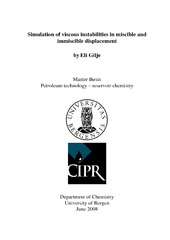| dc.description.abstract | This study includes modeling of viscous instabilities at both miscible and immiscible displacement. Oil recovery of heavy oil leads to unstable displacement for adverse mobility ratio for both miscible and immiscible displacement. Simulation studies of viscous fingering in miscible and immiscible displacements were performed in order to history match 2D slab laboratory experiments performed at CIPR, Centre for Integrated Petroleum Research. History matching of a polymer flood experiment is also included in this thesis. All simulations were performed using UTCHEM, a chemical flooding simulator developed at the University of Texas at Austin. In the laboratory experiment, viscous fingering was observed for the miscible displacement at unfavorable mobility ratio. For the miscible displacement at favorable mobility ratio, an indifferent displacement process (more piston-like displacement) was observed. For the immiscible displacements, both at unfavorable mobility ratio, viscous fingering was only observed in the case with zero initial water saturation. The presence of capillary pressure, however, smeared out the front of the fingers, turning the displacement process indifferent over time. At unfavorable mobility ratio, a water flood experiment was followed by a polymer flood. During the polymer flood an oil bank was accumulated, and considerable additional oil was produced. To history match the miscible displacement an approach was tried by using variation in local grid block permeability. This approach with large variation in permeability field, miscible displacement showed overall good agreement with the experimental results. The miscible displacement at favorable mobility ratio, when simulated in UTCHEM, showed an indifferent type displacement process. The simulation model of the miscible displacement at unfavorable mobility ratio, showed the formation of viscous fingering very similar to that obtained in the laboratory experiment. The applied method of permeability distribution seems to match both displacements at favorable and unfavorable mobility ratio. The simulated model for immiscible displacement at Swi=0, did not generate viscous fingers. The establishment of water films is most likely a fast kinetic reaction that is not included in the simulator and is therefore not observed in UTCHEM. The UTCHEM simulator did, however, provide similar results for the immiscible displacement at Swi=0.12. The applied capillary pressure in the immiscible displacements causes smearing of the front, which results in an indifferent type displacement. The simulation model of the polymer flood following a water flood showed the accumulation of an oil bank very similar to observed experimental results. In order to match the oil bank formation and oil recovery by polymer flooding, the residual oil saturation in the simulation model had to be reduced from the residual oil saturation by water flooding (Sor,w=0.47), to a lower residual oil saturation after polymer flooding (Sor,p=0.31). The approach of only changing endpoint saturations and including the physical chemistry properties of the polymers, was able to give a good history match of the experiment. | en_US |
